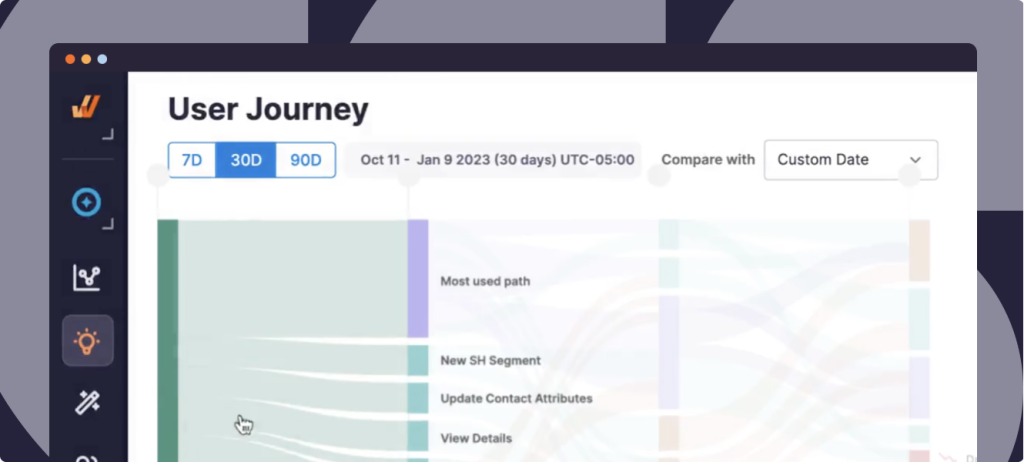Your employees’ performance directly impacts productivity, innovation, and overall business success. But how do you ensure employees meet expectations, improve over time, and contribute to company goals?
Measuring team member performance is crucial for identifying top performers, addressing skills gaps, creating personalized development plans, and improving employee performance overall. A well-structured framework for tracking and analyzing employee performance enables managers to recognize achievements, provide constructive feedback, benchmark productivity levels, identify areas of improvement, and align employee efforts with organizational objectives.
In this article, we’ll explore the best practices for measuring employee performance, introduce key evaluation metrics, and discuss the factors influencing fair and effective performance assessments. By implementing a structured approach, businesses can foster a culture of continuous improvement, enhance employee engagement, and drive long-term success.
What Is Employee Performance?
Employee performance evaluation is the structured process of assessing an individual’s effectiveness, productivity, and contributions within an organization. It involves measuring key performance indicators (KPIs), analyzing qualitative feedback, and identifying opportunities for growth. This process ensures employees align with business objectives and receive the necessary support to improve their skills and efficiency.
Key components of employee performance evaluation
A comprehensive performance evaluation typically includes:
- Goal alignment: Assessing how well employees meet individual and company objectives.
- Productivity metrics: Measuring task completion rates, efficiency, and output quality.
- Skill gap analysis and competency assessment: Identifying strengths, weaknesses, and areas for improvement.
- Behavioral and soft skills review: Evaluating teamwork, communication, leadership, and adaptability.
- Continuous feedback & development: Providing ongoing coaching, mentoring, and training opportunities focusing on specific employee development areas.
Best Practices for Measuring Employee Performance
Measuring employee performance is crucial for business success. Here are seven key best practices for evaluating performance and driving professional growth within an organization.
1. Set measurable OKRs and individual goals
Objectives and Key Results (OKRs) provide a structured framework for goal-setting and performance measurement. By breaking down larger company objectives into measurable key results, employees can track progress, stay motivated, and prioritize their tasks effectively.
How to implement OKRs:
- Align individual OKRs with company-wide strategic goals.
- Make goals SMART (Specific, Measurable, Achievable, Relevant, Time-bound).
- Use performance-tracking tools to monitor progress and provide regular feedback.
For example, if a sales associate’s goal is to increase customer retention by 15%, their OKRs could include conducting follow-up calls with at least 50 clients per month and reducing customer churn by 5% in six months.
✓ Thank you, the checklist will be sent to your email
2. Benchmark performance by implementing ‘sprints’
Borrowed from agile methodology, sprints are short, focused work cycles in which employees complete specific tasks within a set timeframe—typically one to two weeks. This method enhances accountability, productivity, and adaptability.
Here’s how to implement sprints:
- Assign employees clear weekly or biweekly tasks with deadlines.
- Conduct sprint retrospectives to analyze performance trends and improvements.
- Use sprint tracking tools such as JIRA, Trello, or Asana to monitor workloads.
Sprints help teams reflect on their working processes, making adjustments to improve efficiency while ensuring they meet short-term and long-term goals.
3. Implement a project or task management tools
Using project management software ensures employees stay on track with their tasks while enabling managers to monitor performance in real-time. These tools increase workflow transparency and productivity.
Here’s how to implement project management tools:
- Adopt tools such as Asana, Basecamp, Monday.com, or Microsoft Project to streamline task assignments.
- Track KPIs such as task completion rates, missed deadlines, and productivity trends.
- Use dashboards and reports to gain insights into individual and team performance.
For instance, a customer support team can use a project management tool to assign and track resolution times for support tickets, ensuring high-priority issues are resolved efficiently.
4. Collect peer feedback
360-degree feedback allows organizations to gather insights from colleagues, managers, and subordinates (or direct reports) to create a well-rounded performance evaluation.
Here’s how to collect peer feedback:
- Conduct anonymous surveys to encourage honest feedback.
- Evaluate qualitative (teamwork, leadership, communication) and quantitative performance data.
- Provide constructive feedback sessions to discuss strengths and areas of improvement.
For example, peer feedback may highlight an employee’s strong collaboration skills but identify a need for improvement in time management, allowing managers to tailor employee development plans accordingly.
5. Track training completion
Employee training programs help bridge skills gaps and improve workforce efficiency. Measuring training completion rates ensures employees continuously learn and adapt to evolving business requirements.
How to track training completion:
- Monitor training progress and certifications using employee training software such as learning management systems, or digital adoption platforms.
- Set up training milestones and completion deadlines for professional development.
- Analyze post-training performance to assess the effectiveness of learning initiatives.
For instance, HR teams can track whether employees complete cybersecurity training modules and implement new security protocols in their workflows.
6. Track, measure, and analyze digital adoption and process completion KPIs
With the increasing reliance on digital tools, organizations must assess how effectively employees adopt and utilize workplace technology. Measuring digital adoption provides actionable insights into productivity, efficiency, and training effectiveness—helping organizations pinpoint user friction points and optimize workflows.
Organizations can track, benchmark, and improve end-user adoption by:
- Utilizing Whatfix Digital Adoption Platform (DAP) analytics to track user interactions, engagement levels, and feature adoption within enterprise software.
- Measuring task completion rates, time spent on key workflows, and error frequencies to identify areas where employees struggle.
- Using Whatfix’s real-time insights to measure training effectiveness by monitoring how well employees retain and apply knowledge.
- Supporting employees in the flow of work with in-app guidance, automation, and self-help tools to support employees exactly when and where they need assistance.
For example, if an organization notices employees underutilizing a newly deployed CRM, Whatfix analytics can reveal which features are frequently ignored or where users drop off. Based on these insights, L&D teams can deploy interactive walkthroughs, tooltips, and smart tips to guide employees through critical functions, ensuring successful adoption and improved performance.
By integrating AI-powered analytics with contextual learning, Whatfix enables organizations to continuously measure, refine, and enhance employee performance in real time.


→ Gain insights into user engagement and analyze application usage with our easy-to-implement, yet powerful codeless event tracking.
→ Benchmark time-to-completion of core tasks and identify areas of workflow friction.
→ Capture user feedback with in-app surveys to mix qualitative insights with your quantitative data.
7. Benchmark performance against peers
Comparing employee performance against industry standards or internal benchmarks helps assess growth potential and development needs.
Here are a few tips to help your organization or team benchmark employee performance:
- Utilize the 9-box grid method to categorize employees based on performance and growth potential.
- Conduct a skills gap analysis to measure competency levels and training needs.
- Set benchmarks using historical performance data, industry insights, and peer comparisons.
For example, if a sales team’s average conversion rate is 10%, but industry benchmarks suggest 15%, the organization can identify skill gaps and provide targeted training to boost performance.
Related Resources
Reasons To Measure Employee Performance
Effectively measuring employee performance fosters growth, accountability, and business success. Here’s why it matters:
- Measuring performance sets expectations: Employees perform best when they know what’s expected. Clear performance benchmarks ensure alignment with company goals, reducing uncertainty and improving focus. According to Gallup, only 47% of employees strongly agree that they understand their job expectations.
- Allows managers to benchmark performance levels: Comparing individual and team performance against internal and industry standards helps identify gaps and areas for improvement. For instance, if a customer service team’s average response time is 90 seconds while the industry standard is 60 seconds, it signals a need for optimization.
- Improves employee development and drives retention: Regular performance evaluations highlight skills gaps and provide opportunities for training and career growth. An article by Workforce Africa reports that companies with strong employee development programs see 34% higher retention rates.
- Identifies high performers and future leaders: Performance tracking helps recognize top contributors and potential leaders. The HBR notes that high performers are 400% more productive in complex roles than underachievers.
- Drives company growth and success: Measuring performance ensures business objectives are efficiently met, fostering innovation and operational excellence.
Performance measurement is not just about tracking output—it’s about empowering employees to grow, succeed, and contribute to company goals. By setting clear expectations, benchmarking progress, and fostering continuous development, organizations can build a high-performing, engaged workforce.
Metrics to Evaluate Your Employee’s Performance
Evaluating employee performance requires a data-driven approach that balances quantitative results with qualitative insights. Below are key performance metrics categorized into essential areas to provide a holistic view of employee effectiveness.
- Productivity metrics
- Quality of work metrics
- Engagement and retention metrics
- Learning and growth metrics
- Collaboration and leadership metrics
- Customer satisfaction metrics
Here are ten metrics that empower managers to evaluate their employee’s performance levels.
Productivity Metrics
Productivity metrics measure an employee’s efficiency and output within a given timeframe. These indicators help managers assess whether employees are meeting performance expectations and contributing to business goals.
Revenue per Employee
Measures how much revenue each employee generates, helping assess overall workforce efficiency.
Formula: Total Revenue/Number of Employees
Example: A Saas company generating $10M with 1000 employees has a revenue per employee of $10,000.
Task Completion Rate
Task completion rate tracks the percentage of assigned tasks an employee completes within a set period.
Formula: (Completed Tasks/Assigned Tasks) x 100
Example: A software developer completes 90% of assigned tickets in a sprint, indicating strong task management skills.
Utilization Rate
Measures the percentage of an employee’s available work hours spent on productive tasks.
Formula: (Billable Hours/Assigned Tasks) x 100
Example: A consultant with an 80% utilization rate effectively balances project work and admin tasks.
Time to Task Completion
Also known as cycle time, this is the time taken to complete a task, helping managers assess efficiency and identify workflow bottlenecks.
Example: A sales rep takes an average of two days to follow up with leads, compared to the team benchmark of one day.
Quality of Work Metrics
Measuring the quality of work ensures that employees are not just completing tasks but doing so with accuracy and effectiveness.
Error Rate
Tracks the number of mistakes per task, helping assess attention to detail and accuracy.
Formula: (Number of Errors/Total Tasks Completed) x 100
Example: A financial team monitors spreadsheet errors—aiming to keep the error rate below 2%.
Customer Satisfaction Score (CSAT)
Formula: (Positive Responses/Total Responses) x 100
Example: A customer service agent with a CSAT score of 92% consistently provides high-quality support.
Peer & Manager Evaluations
Collects qualitative feedback from peers and supervisors to assess collaboration, professionalism, and reliability.
Example: A project manager receives high ratings in communication from cross-functional teams, indicating strong leadership skills.
Compliance & Accuracy Rates
Tracks adherence to company policies and industry regulations and ensures work accuracy in process-driven roles.
Example: A healthcare administrator maintains 99% compliance in patient data entry, reducing errors in medical records.
Engagement and Retention Metrics
Gallup’s decades of employee engagement research describe how engaged employees consistently drive better business outcomes—regardless of industry, company size, nationality, or economic conditions. In other words, engaged employees are more productive, satisfied, and committed to their organization. These metrics help assess morale and retention risks.
Employee Net Promoter Score (eNPS)
Measures how likely employees are to recommend the company as a workplace.
Formula: % Promoters – % Detractors
Example: An eNPS of +60 indicates a strong workplace culture and employee satisfaction.
Turnover & Retention Rates
Tracks the percentage of employees leaving vs. staying over a given period.
Formula: (Employees Who Left/Average Total Employees) x 100
Example: A company with a 90% retention rate successfully retains its workforce through strong engagement initiatives.
Absenteeism Rate
Measures the percentage of unplanned absences, helping assess employee well-being and job satisfaction.
Formula: (Total Unplanned Absence Days/Total Workdays) x 100
Example: A high absenteeism rate signals potential disengagement or workplace stress issues.
Internal Mobility Rate
Tracks how often employees are promoted or move into new roles within the company.
Formula: (Internal Moves/Total Hires) x 100
Example: A company with a 40% internal mobility rate successfully nurtures career growth opportunities for employees.
Learning and Growth Metrics
These metrics evaluate skill development, learning retention, and innovation—key factors in career progression and long-term business success.
Training Completion Rate
Tracks how many employees complete assigned learning programs.
Formula: (Completed Training/Assigned Training) x 100
Example: A 95% completion rate in cybersecurity training ensures employees stay updated on data protection protocols.
Skill Development Score
Measures improvement in an employee’s skill over time through assessments or performance reviews.
Knowledge Retention Rate
Assess how well employees retain information post-training, often measured through follow-up assessments.
Example: Employees who score 85%+ on a post-training quiz demonstrate strong knowledge retention.
Innovation & Idea Contributions
Tracks how often employees submit ideas or solutions for improving processes or products.
Example: A product team tracks feature suggestions submitted per quarter to gauge innovation levels.
Collaboration and Leadership Metrics
Collaboration and leadership skills are essential for team success and organizational growth.
360-degree Feedback Scores
Gathers evaluations from peers, direct reports, and managers to assess leadership and teamwork.
Example: A manager consistently rated highly in conflict resolution, and mentorship is a strong candidate for promotion.
Teamwork & Cross-Departmental Collaboration
Measures how well employees contribute to team projects and work across functions.
Example: An HR team tracks participation in company-wide initiatives to gauge employee engagement.
Leadership Potential Assessment
Identifies employees with strong decision-making, problem-solving, and people management skills.
Example: A junior employee taking on mentorship responsibilities signals leadership potential.
Customer Satisfaction Metrics
Customer satisfaction directly reflects employee performance in service-related roles.
Customer Retention Rate
Tracks how well employees contribute to customer loyalty and repeat business.
Formula: ((Customers at End – New Customers)/Customers at Start) x 100
Example: A 90% customer retention rate indicates strong relationship management by account managers.
Service Response Time
Measures how quickly employees respond to customer inquiries or issues.
Example: A support team with an average response time of 30 minutes improves customer satisfaction.
Client Satisfaction & Loyalty Scores
Surveys customers to evaluate their experience and likelihood to continue business with the company.
Example: A post-service customer survey reveals that 85% of clients rate their experience as “excellent,” indicating strong customer loyalty and satisfaction.
Measuring employee performance requires a balanced approach considering productivity, quality, engagement, learning, collaboration, and customer impact. By leveraging these metrics, organizations can make informed decisions, optimize workforce strategies, and drive long-term success.
Key Factors That Influence Employee Performance Evaluations
A well-rounded employee performance evaluation considers multiple factors beyond just task completion. Evaluations should measure an employee’s ability to meet goals, the quality of their work, and how they contribute to the broader team and company objectives.
Here are the key factors that influence performance assessments:
Goal achievement
One of the primary indicators of performance is whether an employee meets or exceeds their individual and organizational goals. Employees who consistently reach their objectives demonstrate strong focus, accountability, and effectiveness.
Factors to consider:
- Has the employee successfully completed key projects within the expected timeframe?
- Do they show proactive problem-solving when facing obstacles?
- Are they aligning their efforts with company goals and contributing to broader business success?
For instance, a sales representative with a quarterly goal of closing 10 new deals consistently achieves or surpasses this target, indicating high performance and goal alignment.
Quality of work
Beyond task completion, the accuracy, thoroughness, and impact of an employee’s work are crucial. High-quality work contributes to customer satisfaction, team efficiency, and business success.
What factors to consider:
- Does the employee maintain high standards of accuracy in their work?
- How often does their work require revisions or corrections?
- Are they producing meaningful, value-driven outputs?
For example, a content writer who submits error-free, high-impact articles requiring minimal edits demonstrates a strong quality of work and attention to detail.
Efficiency and productivity
Efficiency reflects an employee’s ability to manage time, prioritize tasks, and maximize output without compromising quality. Productive employees contribute to business success by completing work in a timely and organized manner.
What to consider:
- How well does the employee manage their workload?
- Do they meet deadlines without compromising quality?
- Are they optimizing resources and tools to improve efficiency?
For instance, a project manager who consistently delivers projects on time and within budget while effectively managing team resources is highly efficient and productive.
Collaboration and teamwork
Workplace success relies on employees’ ability to communicate, collaborate, and contribute to team dynamics. Employees who excel in teamwork help foster a positive work culture and drive shared success.
What factors to consider:
- Does the employee actively participate in team discussions and initiatives?
- Do they collaborate well across departments and support colleagues when required?
- How well do they communicate and resolve conflicts?
For example, A software engineer who works closely with designers and product managers to align on project requirements, ensuring a seamless product delivery cycle, demonstrates strong teamwork.
Learning and adaptability
Employees who are open to learning, adaptable to change, and willing to upskill are more likely to succeed in dynamic work environments. The ability to quickly adjust to new challenges is essential for long-term career growth. What to consider:
- How receptive is the employee to constructive feedback and continuous improvement?
- Do they take the initiative when learning new skills or technologies?
- Can they adapt to process changes, company strategy, or industry trends?
For instance, a marketing specialist who proactively learns new SEO strategies and applies them to improve website traffic shows strong adaptability and commitment to growth.
A balanced employee performance evaluation should go beyond numbers and assess an individual’s goal achievement, work quality, efficiency, collaboration, and adaptability. By considering these factors, organizations can create fair, holistic assessments that support employee growth and business success.
Employee Performance Clicks Better With Whatfix
Measuring performance is only part of the equation—empowering employees with the right tools ensures they reach their full potential. Whatfix in-app performance support provides real-time, contextual guidance directly within enterprise applications, enabling employees to complete tasks without disruption.
How Whatfix transforms employee performance:
- Instant, embedded support: Employees get step-by-step, role-specific guidance exactly when they need it, eliminating reliance on IT or external documentation.
- Faster learning, seamless adoption: Interactive walkthroughs and self-help modules accelerate software proficiency and reduce training costs by 84%.
- Higher productivity, fewer errors: Contextual assistance reduces mistakes, improves efficiency, and helps employees become proficient 65% faster.
Instead of just measuring performance, enhance it with Whatfix. Schedule a demo today to see the impact of just-in-time learning and digital adoption on your workforce.






